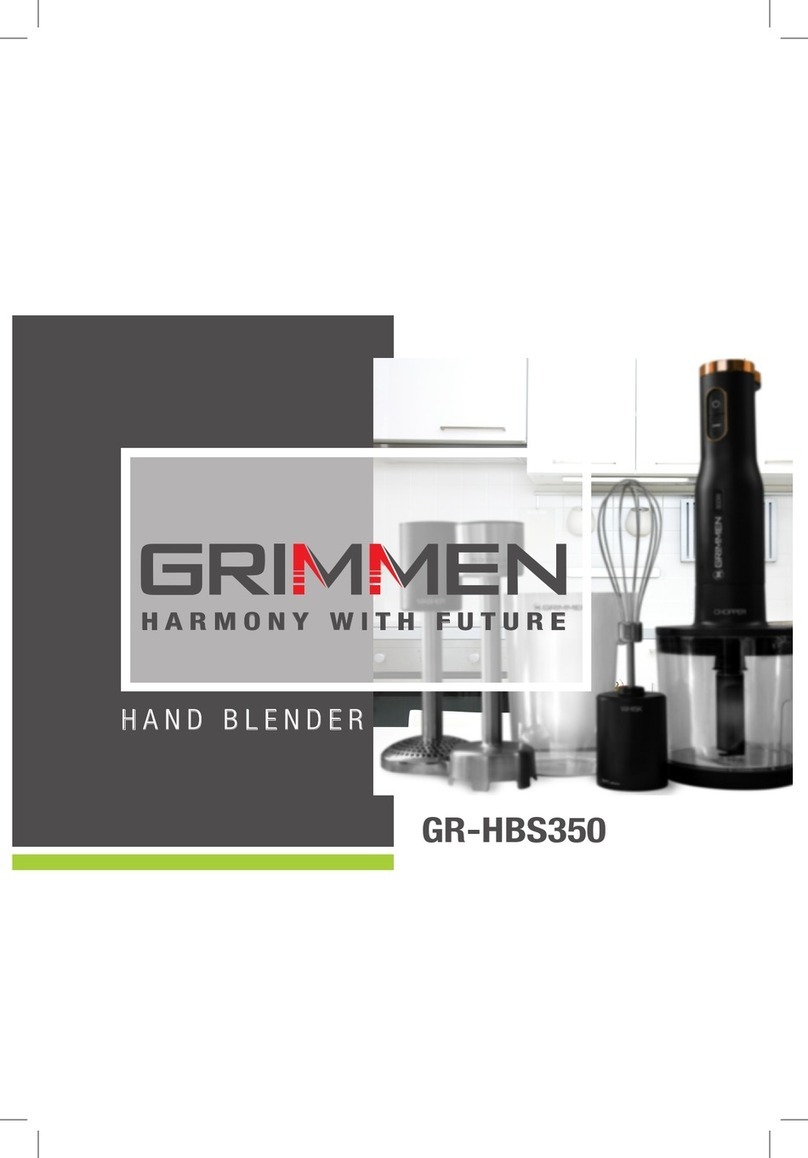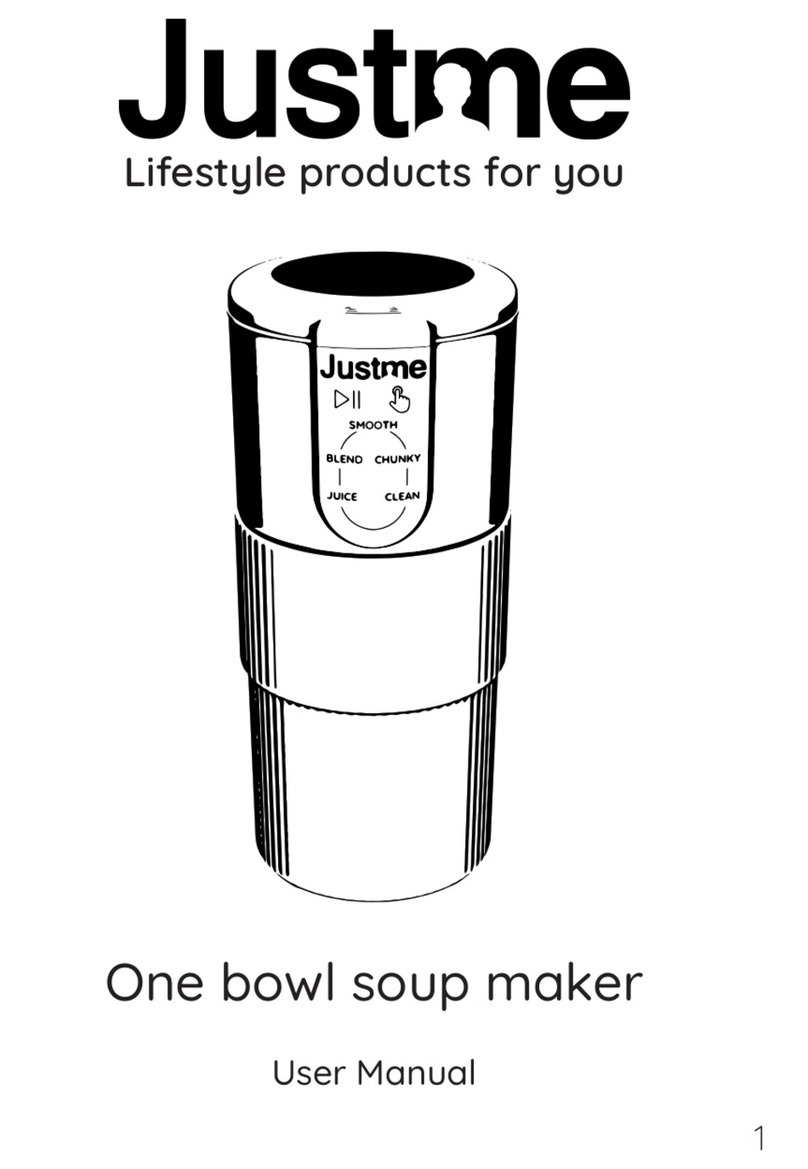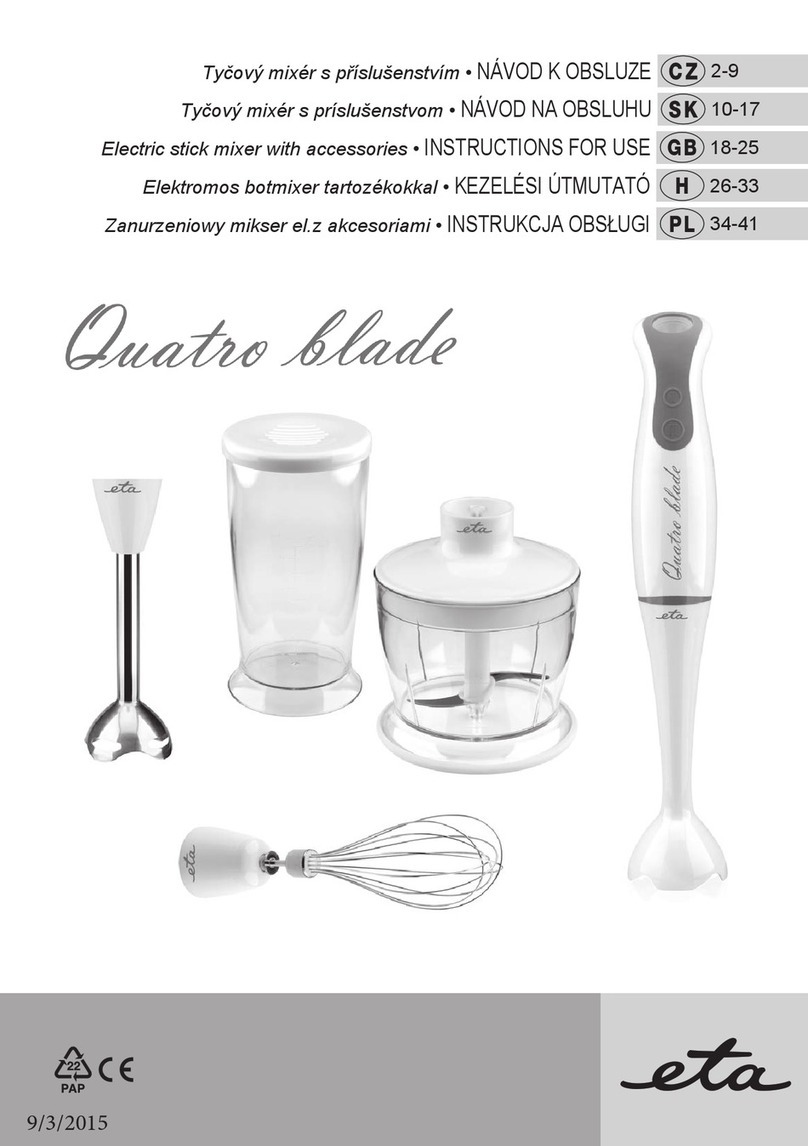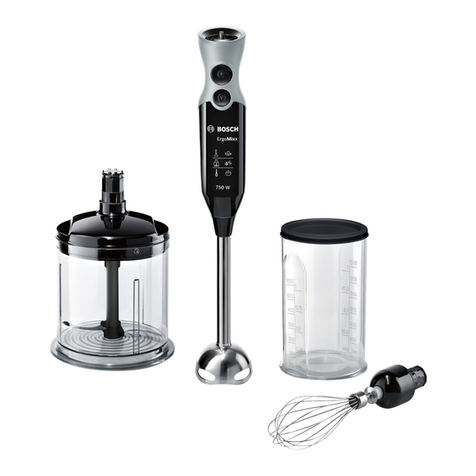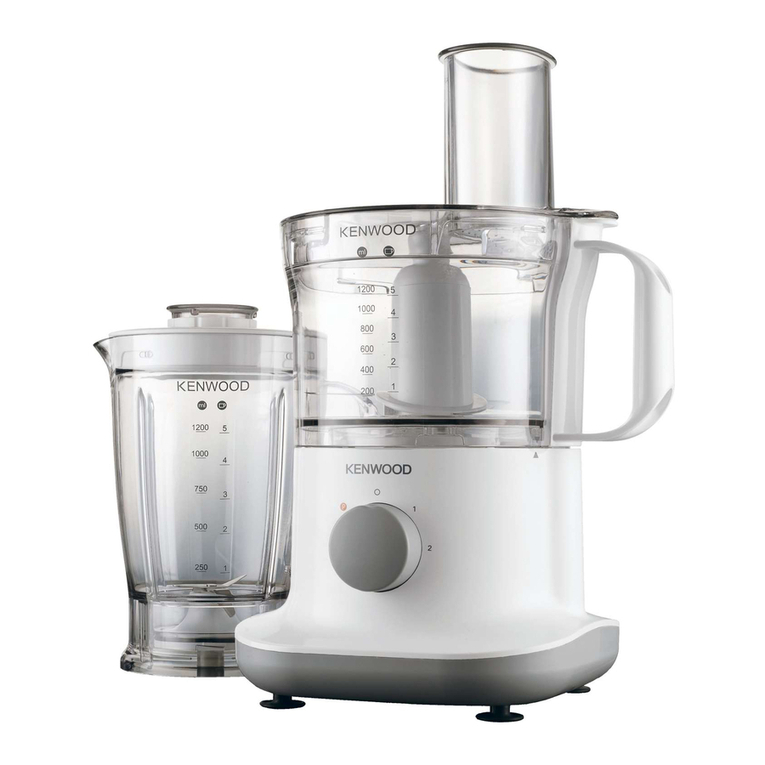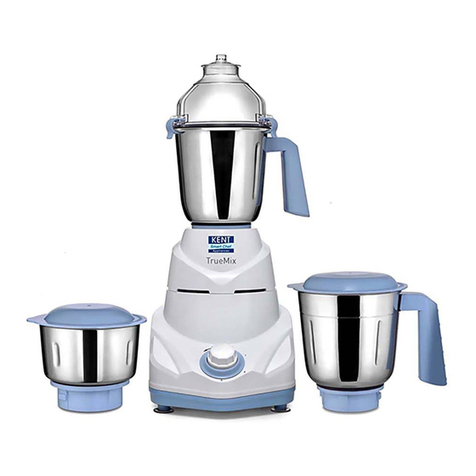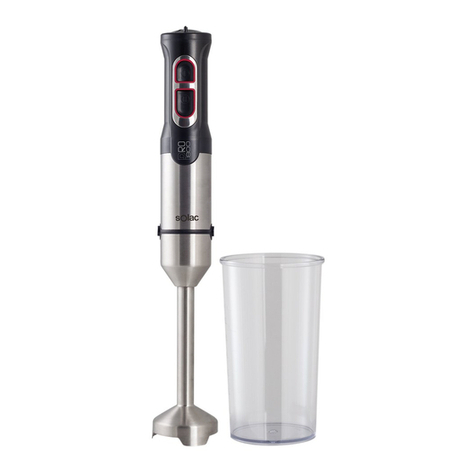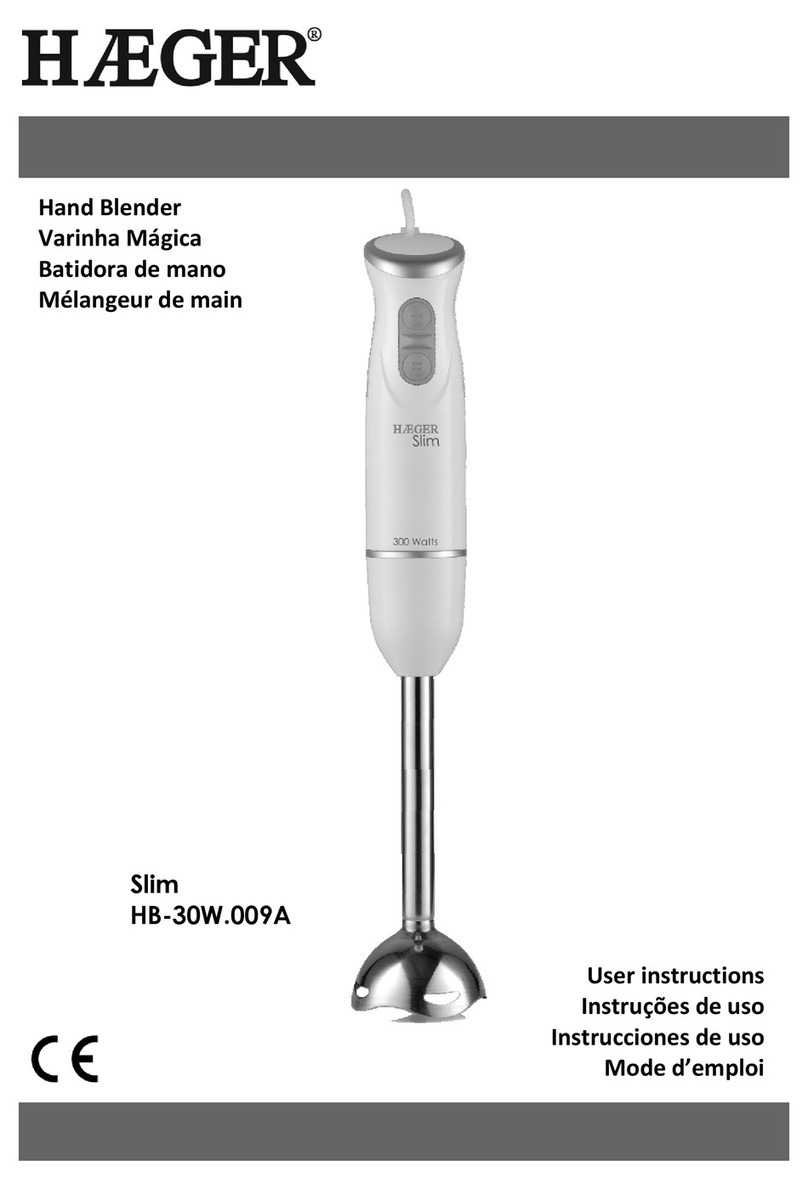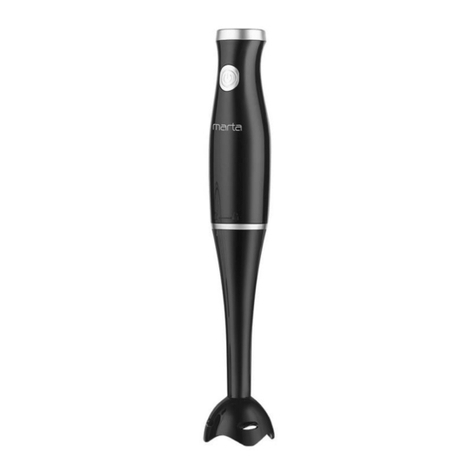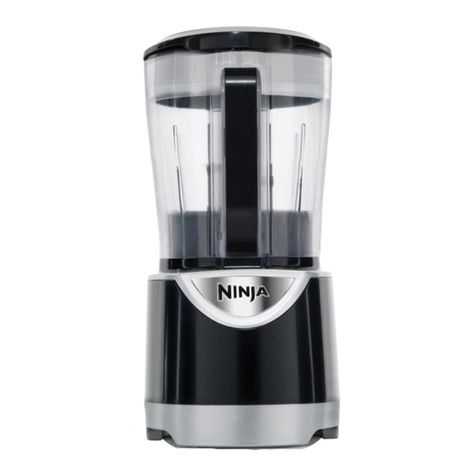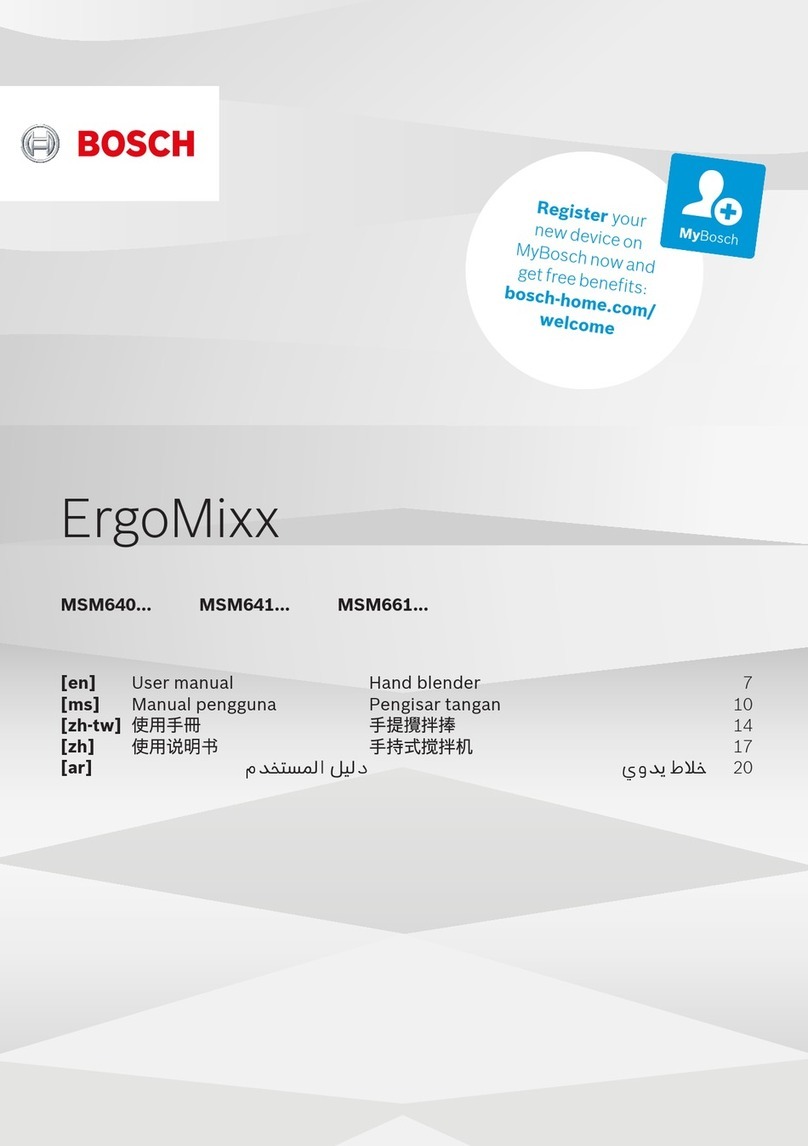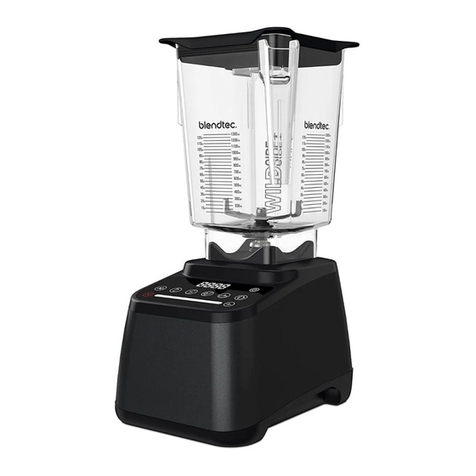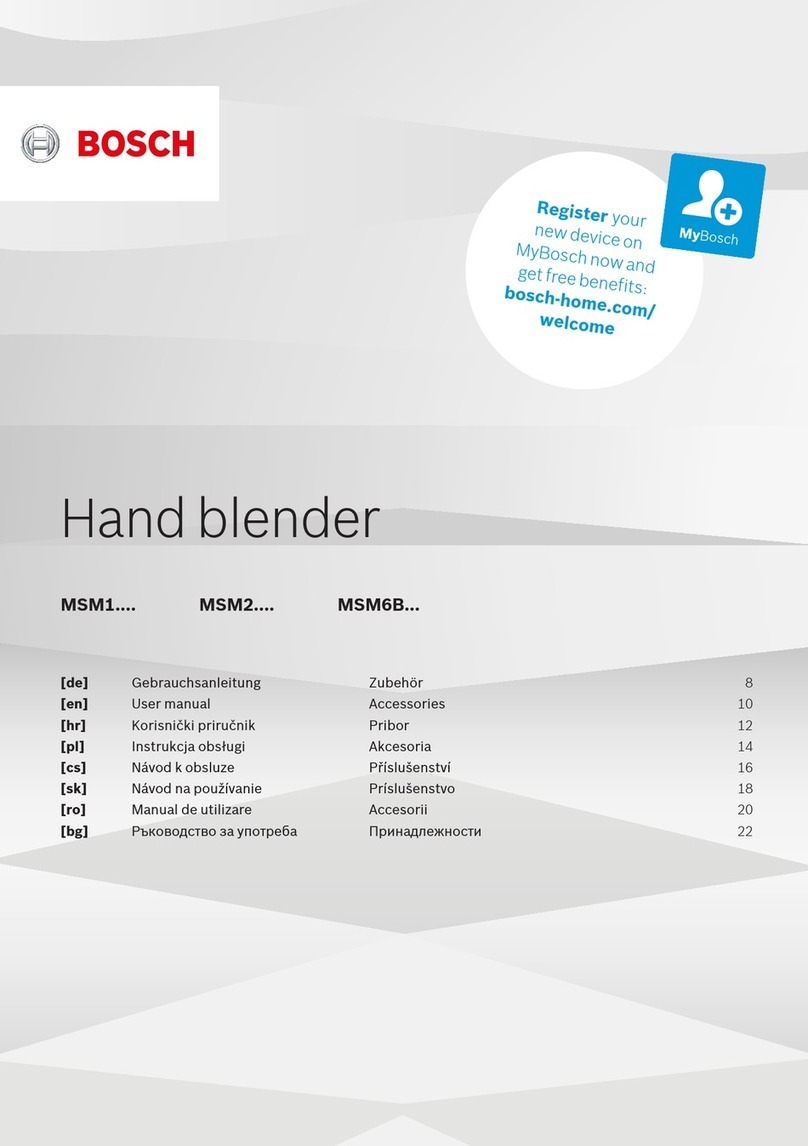Tri-Clover DS3218 User manual

TB-DS-SM-97
Tri-Clover®
Dual Stage Tri-Blender
Model DS3218
Service & Installation Manual

2

3
CONTENTS
Thank you for purchasing a Tri-Clover Product!
This manual contains installation, operation, cleaning and repair instructions, with parts lists, for Dual
Stage Tri-Blenders manufactured by Tri-Clover Inc., Kenosha, Wisconsin. It also provides a
troubleshooting chart to assist in determining blender malfunction.
READ THIS MANUAL
carefully to learn how to service the Tri-Blender.Failure to do so could result
in personal injury or equipment damage.
SAFETY
IMPORTANT SAFETY INFORMATION .......................................................................................... 4
INTRODUCTION
DESCRIPTION................................................................................................................................ 5
BASIC OPERATION ....................................................................................................................... 5
INSTALLATION
INSTALLATION GUIDELINES ........................................................................................................ 6
PIPING HINTS ................................................................................................................................ 7
MAINTENANCE
CLEANING...................................................................................................................................... 8
DISASSEMBLY ............................................................................................................................... 8
REASSEMBLY .............................................................................................................................. 11
SETTING THE DRIVE COLLAR AND SEAL REPLACEMENT..................................................... 15
TROUBLESHOOTING
TROUBLESHOOTING GUIDELINES ........................................................................................... 16
PARTS LIST
MODEL DS3218............................................................................................................................ 18
EXPLODED VIEW ........................................................................................................................ 19

4
IMPORTANT SAFETY INFORMATION
SAFETY
DANGER
WARNING
Indicates an imminently hazardous situation which, if not
avoided,
will
result in death or serious injury. The word
Danger is used in the most extreme cases.
Indicates a potentially hazardous situation which, if not
avoided,
may
result in minor or moderate injury. May
also be used to alert against an unsafe operating or
maintenance practice.
CAUTION
Indicates a potentially hazardous situation which, if not
avoided,
could
result in death or serious injury.
!
Safety is very important!
DO NOT attempt to modify any Tri-Clover product.
To do so could create unsafe conditions and
void all warranties.
DO NOT place any Tri-Clover product in an application where general
product service ratings are exceeded.
The following DANGER, WARNING, AND CAUTION signs and their meanings are used within these
instructions.
Safety labels are placed on every Tri-Blender. Do not remove any labeling on any Tri-Clover product.
Immediately replace any label that is missing.
WA R N I N G
ROTATING SHAFT
DO NOT OPERATE
WITHOUT GUARD IN PLACE
Part Number 38-241

5
INTRODUCTION
DESCRIPTION
The Dual Stage Tri-Blender consists of two basic sections, the dry material section and the liquid
material section.
The Dual Stage Tri-Blender is mounted on a base plate. It is mounted adjacent to the drive motor
and is driven by belts running between pulleys under the base plate. The manually controlled
Butterfly valve is standard equipment.
On this model, the connection ends, the diffuser and the suction tube, the inlet adapter, the casing,
screens, washer, the impellers and backplate are made of 316 stainless steel. The hopper is made of
304 stainless steel. All of the tubes are fastened with quick couple Tri-Clamps for easy care and fast
access. The four legs supporting the Tri-Blender are adjustable for easy leveling of the blender during
installation.
BASIC OPERATION
The Tri-Blender basically consists of a centrifugal pump
head and impeller mounted so that the normal suction
port, or inlet, is pointed upward. The inlet piping
consists of a patented tube-within-a-tube arrangement.
This serves to keep the liquid and dry ingredients
separated until they are in the mixing chamber. The
tube-within-a-tube arrangement eliminates prewetting,
one of the major problems of wet-dry mixing.
Our patented (U.S. Patent # 4,850,704) dual stage Tri-
Blender incorporates the proven design characteristics
of our popular Single Stage Tri-Blender, but takes the
concept a step further for even more efficiency.
The Dual Stage concept provides for "double blending."
The product passes through the initial liquid/dry
ingredient blending chamber directly below to a
secondary chamber, which effectively acts as a
discharge pump.
Due to its close proximity, the dual (or second) chamber concept actually increases, rather than
decreases vacuum. The vacuum from the suction of the second pumping stage is added to that of
the first stage, greatly improving product addition rates. The "double blend" feature improves end
product consistency, providing a smoother, more uniform blend.
With the Dual Stage, in applications up to 500 CPS and up to 50 feet (15m) of discharge head, no
discharge pump is required. This is a significant improvement over the Single Stage units, which
normally require an auxiliary discharge pump at 25 feet (7.5m) of discharge head and above. On
some applications with higher CPS, a discharge pump may be necessary.
By incorporating the discharge pump function into the blender itself, you can achieve e significantly
higher vacuum rates over a wider range of process conditions. The increased vacuum provides for
fast, consistent product flow rates with no drop-off through your entire production run.

6
INSTALLATION
INSTALLATION GUIDELINES
UNPACKING EQUIPMENT
When unpacking your equipment, inspect all of the contents for damage that may have occurred
during shipping. Report any damage to the carrier.
LOCATION AND INSTALLATION
The Tri-Blender unit should be located within 3 feet of the liquid source for best performance and in a
position where the supply piping can be short and direct with a minimum number of elbows and
fittings. The liquid to the blender must be supplied by an auxiliary source. It should also be readily
accessible for cleaning and inspection.
The Tri-Blender unit is ready to install as received from the factory. A minimum space of 32" x 47"
(81cm x 119cm) is required. Install the adjustable legs in the base of the unit and position the blender
in the area it will be used. Turn the adjusting leg with a wrench and individually adjust the legs until
the unit is level.
Attach the supply and discharge piping. Be sure that both the inlet and outlet tubes are correctly
positioned and that supply and discharge piping are properly supported to avoid strain on the blender
casing.
The tube OD of the inlet and outlet connections of the blender casing are:
Liquid Inlet Liquid Outlet Powder Inlet
1½" (38.1mm) 2" (50.8mm) 3" (76.2mm)
IMPORTANT: If your blender is equipped with the electrically controlled Butterfly valve,
be sure the valve is wired to an auxiliary 110V power source. The axillary
wiring will let the Butterfly operate independently from the blender motor
and will allow the valve to be closed if the drive motor stops running. If
the auxiliary 110V power source also fails, the Butterfly valve is equipped
with a manual override to close (or open) the valve by applying a suitable
size wrench to the flats on the coupling adapter.

7
INSTALLATION
PIPING HINTS
GENERAL
This section provides some hints on piping installation, which will aid in obtaining maximum efficiency
and service from your Tri-Blender.
Piping should be independently supported at both the inlet and discharge outlet. Care should be
taken that piping is properly aligned and does not put any strain on the Tri-Blender casing. The piping
should have minimum line restriction.
INLET PIPING
The inlet piping should be short and follow a direct route with a minimum number of elbows and
fittings. Elbows should not be used at the inlet as friction would be greatly increased, resulting in
head loss. Excessive friction losses in the inlet line could cause cavitation in the blender casing,
causing poor performance, noise, vibration, and damage to equipment.
Whenever practical, the diameter of the piping at the inlet should be increased in size. An eccentric
tapered reducer should be used in lieu of a concentric tapered reducer to help direct the flow into the
offset tee to minimize turbulence.

8
MAINTENANCE
CLEANING
GENERAL
The Tri-Blender is relatively maintenance free, requiring normal cleaning and inspection to ensure
optimum performance. Inspect all seals for cuts or abrasions and inspect seal faces for nicks and
cracks. Replace worn or damaged parts as necessary.
REPAIR INFORMATION
Repair of the Tri-Blender is normally accomplished by replacing defective parts. The only moving
parts are the control valve, the impellers, the drive shaft, the seal, the belt, and the motor armature
shaft. It is recommended that all parts of the Tri-Blender be periodically inspected to prevent
malfunctions caused by worn or broken parts. For repair or replacement of the drive motor, refer to
the motor manufacturer. For repair and service of the Butterfly valve on your blender, refer to
B
Series Butterfly Valve Service and Installation Manual (B51SM)
available from Tri-Clover. Refer to
the parts list for replacement data for the Tri-Blender parts.
TRI-BLENDER DISASSEMBLY
1. Remove the clamp (3) securing the hopper (1) to the blender and remove the
hopper and gasket (4).
2. Remove the clamp (3) securing the control valve (5), and remove the valve and
gasket (4). (Hold the valve while loosening the clamp to prevent the valve from
falling.)
3. Remove the clamp (8) securing the diffuser and suction tube (7), and remove the
diffuser and suction tube and gasket (9).
4. Remove the clamp (8) securing the inlet adapter (10), and remove the inlet adapter and gasket (9).
Relieve pressure and
remove all fluid from blender
prior to disassembly.
Remove power before
servicing to prevent
unintended start of the
blender.
WARNING
C.I.P. CLEANING
The Dual Stage Tri-Blender can be cleaned in place. If the Tri-Blender is to be cleaned, the butterfly
valve must be removed and cleaned separately. Refer to separate valve service manual. In addition,
the dry ingredients inlet adapter tube must be capped off.
DISASSEMBLY
98
10
98
7
4
3
5
4
3
1

9
MAINTENANCE
5. Remove the clamp (22) securing the upper casing (11a) to the lower
casing (11b). Grasp the upper casing firmly in both hands and pull the
casing straight up and off of the lower casing.
6. Remove and inspect the casing o-ring (16).
7. Remove the upper screen (12).
8. Using a suitable wrench remove the nut (13) securing the upper impeller
(15a) to the stub shaft. Remove the impeller nut o-ring (14), upper
impeller (15a), and backplate (17).
9. Remove the diffuser plate (51) and lower o-ring (16).
10. Remove the shaft sleeve (54) and o-rings (54a).
11. Remove the lower impeller (15b), and lower screen (12).
12. Remove the o-ring (26) from the lower impeller (15b).
13. Loosen the three casing bolts, and lift the lower casing (11b) off of the
adapter ring.
14. Remove four screws (66) securing the seal gland (67) to the lower casing
(11b). Inspect all parts of the seal for damage or wear and replace as
required. For the DG seal, use caution when handling the casing to avoid
damage to the surfaces around the opening for the carbon seal.
15. Remove the carbon seal (25), o-ring seal (26), cup (27), spring (28) and
drive collar (52) from the stub shaft. To remove the drive collar, loosen
the setscrews (53) and lift the drive collar off of the shaft,
If you need to disassemble the stub shaft and motor, refer to
Stub Shaft and
Motor Removal
following this section.
IMPORTANT: Do not use a tool to pry the casings apart. Any object
inserted between the casing and gasket could cause
damage to the gasket and casing sealing surface,
resulting in leakage after reassembly.
11a
13
14
15a
12
17
68 69
68
67
66a
66
25 26
27
28
52 53
16
51
54
54a
54a
12
15b
26
16
11b
22

10
MAINTENANCE
STUB SHAFT AND MOTOR REMOVAL
Note: When removing drive components, it is
necessary to tip the entire blender and base
on its side, with the motor end toward the
floor. Remove the hopper, valve, tubing,
casing, impeller, seal guard and seal
components before tipping to make the unit
easier to lift.
1. Loosen the mounting bolts (43) securing the drive
motor (50) to the base (39). (The bolt holes are
elongated to permit belt adjustment.)
2. Slide the motor (50) toward the blender and
remove the drive belts (45).
3. Remove the bolts (44b) securing the blender
pulley (44c). Use the same bolts as a forcing
screw and thread it into the forcing holes, finger
tight.
4. With a suitable wrench, turn the bolt (44b) until
the pulley (44c) releases from the bushing (44a).
Remove the forcing screw and remove the
pulley.
5. Slide tapered bushing (44a) from the shaft (31).
6. Loosen the set screws (53) securing the collar
(30) to the shaft (31) and remove the deflector
collar.
7. Loosen the six capscrews (43) securing the
adapter ring spacers (37). Hold the adapter ring
(23) to prevent it from falling. Remove the
capscrews and remove the adapter and spacers.
8. Set the blender down on its legs (41). Remove
the four capscrews (36) and lockwashers (36a)
securing the bearing housing (34) to the base
(39).
9. Grasp the bearing housing (34) firmly in both
hands and lift it out of the blender base (39).
10. Remove the retaining ring (38) and press the shaft (31) out of the housing (34). Using a suitable
puller, remove the bearing (33) from the shaft and remove the other bearing from the housing.
11. Inspect the shaft (31) sealing surface for nicks or scratches. Inspect all components for cracks
and distortion. Inspect the adjusting legs for worn threads and inspect all o-rings for damage.
12. Replace any worn or damaged components.
IMPORTANT: The three bearings in the bearing housing are sealed and lifetime lubricated.
If either of the bearings are worn or damaged, make certain they are
replaced with exactly the same type of bearings and replaced as a set.

11
1. Install the o-ring (26) in the deflector collar (30).
2. Install two bearings (33) on the shaft (31) from the bottom until they rests against
the shoulder.
3. Install the shaft into the bearing housing (34).
4. Install the other bearing (33) on the shaft (31) through the bottom of the housing
(34).
5. Install the retaining ring (38) on the bottom of the shaft (31).
6. Install the bearing housing (34) on top of the base (39) and tighten the bolts.
7. Install the deflector (30) on top of the bearing housing (34).
8. Screw the six spacers (37) into the adapter ring (23), and bolt the spacers onto
the baseplate (39).
9. Install the DG insert into the gland ring with gaskets (68).
Note: If you are using a stainless steel replaceable seat, you won't have
an insert and you'll only use one gasket between the lower casing
and the seat.
10. Install the lower casing (11b) over the shaft (31) and onto the adapter ring.
Use the three casing bolts (11c, shown above) to secure the casing to the
adapter ring.
11. Alternately tighten the spacer bolts (37) to center the shaft (31) in the lower casing (11b).
REASSEMBLY
MAINTENANCE

12
12. Tip the base on its side (39), and install the motor (50).
Tighten the bolts enough so that they contact the
bottom of the base. You’ll use the bolts later to adjust
the belt tension.
13. Install the blender pulley key (44d), pulley (44b), and
bushing (44c) and tighten the bolts (44a). Place the
pulley in position using the correct mounting holes for
the bolts securing the pulley.
14. Install the motor pulley key (46d), pulley (46b), and bushing (46c) and tighten the bolts (46a).
Make sure that both pulleys are horizontally aligned. Draw the pulley tight with the mounting
bolts by alternately tightening each bolt a small amount until all three bolts are tight.
15. Place the drive belt (45) on the motor pulley (46b) and the blender pulley (44b). It may be
necessary to move the motor toward the blender to place the belts on the pulleys. Tighten the
belts by moving the drive motor away from the blender housing until there is a deflection of 5/16"
(7.9 mm) using 5 to 7 pounds of force on the belt. Tighten the motor bolts.
16. Turn the blender upright.
17. Assemble the seal. Refer to
Setting the Drive Collar and Seal Replacement
section (all motors)
at this point. Then return to Step 17.
18. Slide the lower impeller (15b) with the o-ring onto the shaft (31) and down into the lower casing
(11b).
19. Slide the shaft sleeve (54) with two o-rings (54a) onto the shaft (31).
MAINTENANCE

13
20. Install the upper impeller (15a) onto the shaft (31) with the
impeller nut (13) and o-ring (14).
21. Loosen all spacer bolts (43) to set the clearance between the
lower casing and the lower impeller.
22. Select three alternating adapter ring spacers (37) to adjust for a
.015 to .020 inch clearance between the lower casing and the
lower impeller. Adjust the spacers to obtain a level adjustment.
Tighten the three spacers using the base plate screws (43) to
secure the setting. Recheck the clearance to ensure proper
adjustment.
23. Adjust the three remaining spacers (37) to take up the gap
between the end of the spacer and the base plate. (Also takes up
slack in the threads of the first 3 spacers to prevent casing
movement due to thread clearances.)
24. Tighten the three remaining screws (43) of the spacer to the base plate
connections.
24. Remove the upper impeller (15a).
25. Place the lower screen (12) inside the lower casing (11b) with the pin on the
screen facing upward and lined up with the step in the lower casing.
26. Install the diffuser plate (51) on the lower casing (11b), ensuring that the
pin in the plate fits in the notch in the lower casing. (The pin in the lower
screen must also fit inside the notch on the diffuser plate.)
27. Install the back plate (17).
28. Install the upper impeller (15a) onto the shaft with the impeller nut (13) and o-ring (14).
29. Install the upper screen (12) with the pin down. Rotate the screen counterclockwise until it rests
against one of the tabs on the back plate (17).
MAINTENANCE

14
30. Install the upper casing with o-ring, ensuring that the pins on the upper casing fit into the notches
on the lower casing, and install and tighten the clamp.
31. Install the seal guard (36).
32. Install the inlet adapter (10) on the casing (11),
securing it with a clamp.
33. Install the diffuser and suction tube (7) and gasket in
the adapter (10), and secure it with a clamp.
34. Install the butterfly valve (5) and gasket, and secure
it with a clamp (3).
35. Install the hopper (1) and gasket (4) , and secure it
with a clamp (3).
MAINTENANCE
IMPORTANT: Be sure to position the adapter (10)
correctly. The adapter inlet should be
opposite the casing outlet (11). See
figure at right.

15
Complete these steps before returning to final reassembly steps in
preceding section.
1. Slide the drive collar and seal assembly toward the seal seat until
the nose of the drive collar pushes the o-ring and carbon seal tight
against the seal seat.
2. Slide the drive collar away from the seal seat 1/32 inch (0.8mm) and
secure the drive collar in this location with the set screws.
3. Remove the impeller screw and the upper impeller.
4. Insert the lower impeller screen with the pin up to align with the hole
in the diffuser.
5. Install the diffuser with an o-ring in the lower casing.
6. Install the backplate onto the diffuser.
7. Insert the upper impeller screen so the pin faces down and when rotated clockwise rests against
one of the 4 tabs of the backplate.
8. Attach the upper impeller to the shaft with the impeller screw and o-ring.
9. Attach the upper casing and o-ring with the large Tri-Clamp to the lower casing while aligning the
backplate tabs with the upper casing grooves.
10. Assemble the remaining tubes and seals securing each section with the proper size clamps.
1
1. With the blender assembled, and casing clamp tightened, if the drive collar is properly positioned,
and the seal components are properly installed, the blender shaft should rotate freely by hand. If
excessive effort is required to rotate the shaft, check to be sure that all components are properly
installed and the drive collar is properly positioned.
12. Assemble seal guard and tighten nut.
After above setting instructions have been followed, return to the
Reassembly
section for final steps.
SETTING THE DRIVE COLLAR AND SEAL REPLACEMENT
MAINTENANCE

16
Tri-Blenders are relatively maintenance free with the exception of sanitizing and inspection. Like any
piece of machinery, however, occasional problems can arise. This section provides a means of
determining and correcting most of your Tri-Blender problems. The motor manufacturer should be
contacted for specific repair instructions on the motor.
The chart below has been prepared on the basis that the Tri-Blender, as installed, is properly suited to
its application. Should problems arise where the remedies listed below chart do not cure the situation,
impeller cavitation may be the problem. Symptoms of cavitation, such as noisy operation, insufficient
discharge and vibration, can result when the auxiliary pump or suction tube are not properly applied. If
these conditions are present, check the system and reevaluate the application. If assistance is
required, contact Tri-Clover.
TROUBLESHOOTING GUIDELINES
PROBLEM
1. No suction.
2. Insufficient
discharge.
PROBABLE CAUSE
a. Wrong supply pump or need of
discharge pump.
b. Leak on the suction side of the
supply pump or blender.
c. Carbon seal is worn.
d. Wrong direction of rotation.
e. Inlet port on wrong side.
f. Splashing in the suction throat
of the Tri-Blender.
g. High viscosity.
h. High temperature.
a. High viscosity with screen in
casing.
b. No liquids.
c. Product too viscous or
discharge head too great.
REMEDY
a. Verify that pumps are sized correctly to
suit application. Contact Tri-Clover if
you require assistance.
b. Tighten all clamps, fittings - replace worn
out gaskets.
c. Replace carbon seal on blender and/or
supply pump.
d. Reverse a three phase motor by
switching any of the three power leads at
the motor or controller on blender or
supply pump.
e. Remove inlet adapter housing and
relocate so it is correctly positioned as
shown on the exploded view pages.
f. High Flow - oversized supply pump; see
1a above; see 1e above.
g. See 3b.
h. Reduce temperature below 140°F
(60°C).
a. Remove screen.
b. Check supply pump.
c. Add discharge pump.
TROUBLESHOOTING

17
PROBLEM
3. Excessive
power
consumption.
4. Tri-Blender is
noisy.
5. Excessive
vibration.
6. Tri-Blender
leaks.
PROBABLE CAUSE
a. High viscosity with screen in
head.
a. Magnetic hum in motor.
b. Motor bearings are worn.
c. Tri-Blender bearings are worn.
d. Foreign matter is rotating with
impeller.
a. Blender is not leveled properly.
b. Impeller is damaged.
c. Foreign matter in casing.
a. Seal failure.
b. Casing gasket worn or
damaged.
REMEDY
a. Remove screen.
b. Install discharge pump on discharge end
of the Tri-Blender.
a. Consult motor manufacturer.
b. Consult motor manufacturer.
c. Replace bearings.
d. Remove casing and remove foreign
matter - inspect for damage.
Check supply flow to blender.
a. Level blender.
b. Replace impeller.
c. Remove casing and remove foreign
matter - inspect for damage.
a. Replace seal.
b. Replace gasket.
TROUBLESHOOTING

18
MODEL DS3218
PARTS LIST
All orders for repair parts must contain the following data.
1. Complete model number (located on nameplate).
2. Tri-Blender serial number (located on nameplate).
3. Description and part key number from the parts list.
The exploded views and accompanying parts list facilitate ordering repair parts from the factory. All
parts of the Tri-Blender are exploded and keyed to the parts list.
Key
No. Description Part Number Qty
35 Seal Gaurd F3218D-131-S 1
36 Screw, Bearing Housing SC1510H-SS 5
36a Lockwasher, Bearing
Housing LWA1500-SS 5
37 Spacer DS3218-71A-316L 6
38 Retaining Ring DS3218-177 1
39 Base Plate DS3218-23-S 1
40 O-Ring, Adjustable Leg 01-1154-13-34-U 4
41 Adjustable Leg R3-1-23-03-S 4
42 Washer, Spacer & Motor LWA1700-SS 10
43 Screw, Spacer & Motor SC1712H-SS 10
44 Blender Pulley 50 Cycle DS3218-106-5-3V5.0x1.500 1
44 Blender Pulley 60 Cycle DS3218-106-5-3V6.0x1500 1
44d Blender Pulley Key D3218-46 1
45 "V" Belt D3218-3VX600 5
46 Motor Pulley 50 Cycle DS3218-108-5-3V8.0x1.875 1
46 Motor Pulley 60 Cycle DS3218-108-5-3V8.0x1.875 1
49 Washer, Motor WA1700-SS 4
51 Diffuser Plate DS3218-5-316L 1
52 Drive Collar SP328D-23P-S 1
53 Setscrew SC1105A-SS 1
54 Shaft Sleeve DS3218-14-316L 4
54a O-Ring, Shaft Sleeve 17-51-U 1
66 Bolt, Gland Ring SC1310H-SS 2
66a Lockwasher, Gland Ring LWA1300-SS 4
67 Gland Ring (DG Seal) SP328G-17-316L 4
67a Stainless Steel Seat DS3218-17-316L 1
68 PTFE Gasket SP328G-80-1-2-G 2
69 Seal Seat SP328G-80-1-1-Mat'l 1
Key
No. Description Part Number Qty
140° hopper D3218-55-40-01 1
260° hopper D3218-55-60-01 1
3Clamp 13MHHM-2-S 2
4Gasket 40MP-U-2 2
5Manual Butterfly Valve B51A-4-E-S 1
7Difuser & Suction Tube F3218-05-316 1
8Clamp 13MHHM-4-S 2
9Gasket 40MP-U-4 2
10 Inlet Adapter F3218-217-316 1
11a Upper Casing DS3218-1B-01-316L 1
11b Lower Casing DS3218-1A-316L 1
12 Impeller Screen DS3218-215-316 2
13 Screw, upper impeller DS3218-26-316L 1
14 0-Ring, upper impeller 17-15-U 1
15a Upper Impeller DS3218-2B-02-316 1
15b Lower Impeller DS3218-2A-02-316 1
16 O-Ring, casing 17-327-U 2
17 Backplate DS3218-11-316 1
22 Clamp, Casing DS3218-75-S 1
23 Adapter Ring DS3218-71-1-S 1
25 Carbon Seal 328E-80-1A-Mat'l 1
26 O-Ring S328-80-2-U 3
27 Cup 328D-80-3P 1
28 Spring 328D-80-4 1
30 Deflector F3218-40E-S 1
31 Drive Shaft DS3218-06-316L 1
33 Bearings D3218-18 3
34 Bearing Housing F4329-99-S 1

19
EXPLODED VIEW

Tri-Clover
manufactures
a complete line of
TRI-WELD®fittings
TRI-CLAMP®fittings
BEVELSEAT fittings
POSITIVEPUMPS
CENTRIFUGALPUMPS
AUTOMATICAirActuatedVALVES
STAINLESSSTEELTUBING
AUTOMATED FLOW CONTROL SYSTEMS
Terms, Warranty Provisions, Notice of Claims and Limitation of Liability
Pricesandalltermsandconditionsofsaleareestablishedin
currentpricesheetsandaresubjecttochangewithoutnotice. All
ordersaresubjecttoacceptancebyTri-CloverInc.atitsKenosha,
WisconsinorDistributionCenter* offices only. Noassignment of
thepurchaser’srightsmaybemadewithoutconsentofTri-Clover
Inc. EachTri-Cloveritemiswarrantedtobefreefrommanufactur-
ingdefects for aperiod ofone(1) year fromthe dateofshipment,
providingithasbeenusedasrecommendedandinaccordancewith
recognizedpipingpractice,andprovidingithasnotbeenwornout
duetosevereservice,suchasencounteredunderextremelycorro-
siveorabrasiveconditions.
Thiswarrantyisexpresslyinlieuofanyotherwarranties,
express or implied, including but not limited to, any implied
warranty of merchantability or fitness for a particular pur-
pose.
Allclaimsmustbeinwritingandmustbemailedordelivered
by purchaser within thirty (30) days after purchaser learns of the
factsuponwhichsuchclaimisbased. Anyclaimnotmadeinwriting
andwithinthetimeperiodspecifiedaboveshallbedeemedwaived.
Purchaser’s sole and exclusive remedy and Tri-Clover
Inc.’s maximum liability for claims arising hereunder or for
negligenceforanyandalllossesanddamagesresultingfrom
anycauseshallbeeithertherepairorreplacementofdefective
itemsor,atTri-CloverInc.’soption,therefundofthepurchase
price for such items. In no event, including in the case of a
claimfornegligence,shallTri-Cloverbeliableforincidentalor
consequentialdamagesincludinglossofprofits.
Noperson,includinganyrepresentative,employeeoragentof
Tri-Clover,isauthorizedtoassumeonbehalfofTri-CloverInc.,any
liabilityorresponsibilityinadditiontoordifferentfromthatdescribed
inthisprovision. Anyandallrepresentations,promises,warranties
orstatementsthatareinadditiontoordifferentfromthetermsofthis
provisionareofnoforceoreffect.
*Distribution Centers in Union City, California and St. Charles,
Missouri.
TB-DS-SM-97
Printed in Nov 1997
2.5M
Table of contents

